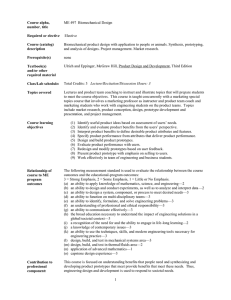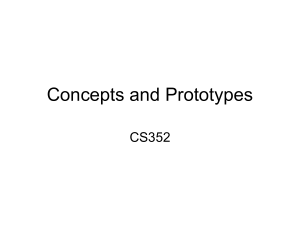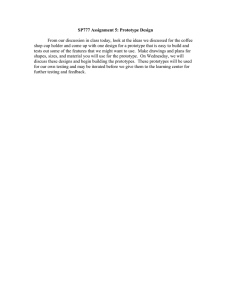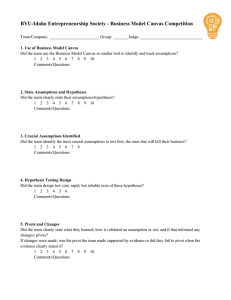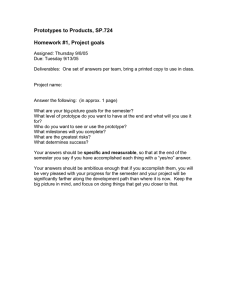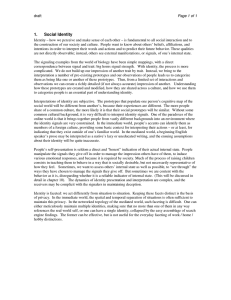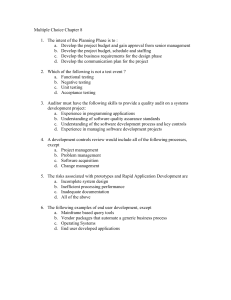Concepts and Prototypes CS352
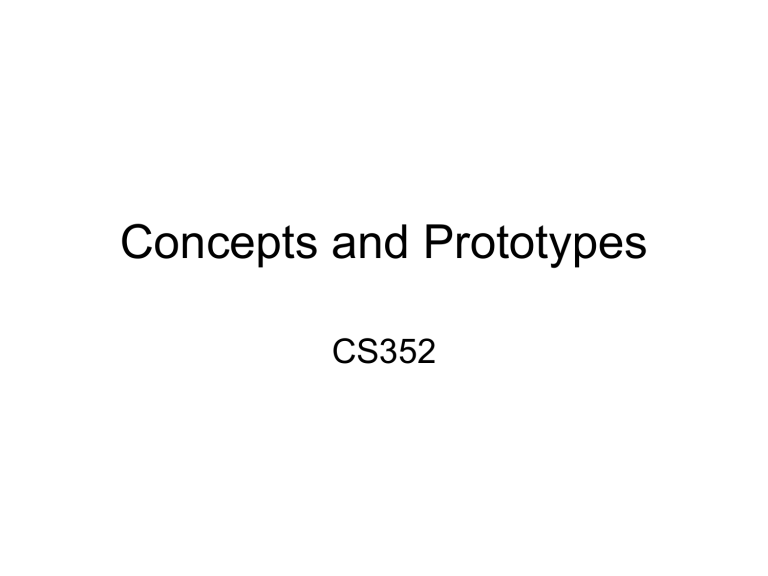
Concepts and Prototypes
CS352
Announcements
• Notice upcoming due dates (web page).
• Where we are in PRICPE :
– P redispositions: Did this in Project Proposal.
– RI : R esearch was studying users. Hopefully led to I nsights.
– CP : C oncept and initial (very low-fi) P rototypes due next.
– Evaluate throughout, repeat iteratively!!
2
Concepts (Conceptual Model)
• Pre-prototype.
• Explore how to address some aspect, eg:
• The interface metaphor (eg, desktop, ...)
• The paradigm or device (eg, WIMP, wearable, ...)
• The interaction type (eg, instructing, conversing, manipulating/demonstrating, or exploring)
• This is a brainstorming-like tool
– Consider several concepts.
– There should be some bad ideas!
– 1. don ’ t get too attached to a concept and 2. don ’ t spend too much time on any of them.
Concepts
• Examples
– Example #1: The thermostat ideas you presented on the doc cam.
– Example #2: Fig 11.7
– Examples from Mike Madison ’ s homelessness project. (He ultimately scrapped all of them.)
Inklings of a Design…
Mike Madison, Jason De Runa, Jordan Fugate, Sakshi
Gupta
Concept
In-Class Activity
• In your teams:
– Sketch >=3 concepts for the on-line grocery.
Is concept good?
• Questions to try to decide (#2-6 are for metaphor concepts):
1. Does it solve the problem/aspect?
2. How much structure does it provide?
3. How much of it relevant to the problem?
4. Is it easy to represent?
5. Will your audience understand the metaphor?
6. How extensible is the metaphor?
Prototypes
• To flesh out a concept with enough detail
– to communicate/understand user experience in detail.
– in this class: for our use to understand user problems with our ideas.
– can also be used to communicate with boss, news media, etc...
• Lo-fi prototypes ideal for some purposes:
– cheap
– yet force enough attention to detail.
Higher fi prototypes
• Useful:
– When: AFTER get through lower-fi ones first.
– Why: Get at details of design (layout, icons, colors etc)
– Example:
Wizard of oz: on the computer, but human fakes in the computer logic.
• Front end finished with widgets polished up, but behavior/data is hard-coded (no back end).
– For boss, at trade shows, etc.
Lo-fi prototypes
(we will start here)
• Just how lo-fi can one go
– The lowest-fi: paper
• At first: sketches.
• Later can be more polished.
– Static paper vs. “ interactive ” paper.
– There are tool-supported variants of above concepts.
– Details of each next...
Paper prototypes
• Static paper
– For communicating among team.
– Usually done as a written use case or a sketched storyboard or sketched “ state machine ” .
– Ex: Fig 11.2 (storyboard, very high-level).
– Ex: Fig 11.4,11.9 (more detailed storyboards).
– Ex: Fig. 11.17 (very detailed paper prototype, showing planned look/behavior).
– Another very detailed paper prototype (next slide).
Low-fidelity prototype
Paper prototypes (cont.)
• Dynamic (interactive) paper
– For evaluating with user at a very low-cost.
Dynamic/interactive paper prototypes (cont.)
• Examples:
– Example #1: from ML-interaction experiment.
• (Next slide).
– Example #2: Fig 11.11
– Example #3 (if time permits): from spreadsheet study (this one has elements of wizard-of-oz)
– Example #4: Fig 11.15
– Example #5: next next slide
Lo-fi interactive prototype set-up with pens, printouts, table
Example lo-fi prototype
From Christoph Neumann ’ s “ Interactive Football ” strategy programming environment
Tool-supported prototypes
• Low-fi with tool support.
– DENIM (Fig 11.18) and CogTool (fig in an upcoming slide): tools for sketched storyboards/states.
– Can transition these to nicer, more polished versions.
Activity
• Choose one concept you did for the online grocery.
• Consider one specific user task:
– your user wants to buy ingredients to make lemonade.
• Sketch a prototype storyboard/states of your UI:
– that shows how your user will accomplish that task in your UI.
CogTool Example
CS 352 Prototyping
• In here:
– We will begin with static paper,
• then iterate from that start using CogTool, and
• eventually have a more polished version, still in
CogTool.
CogTool
• The prototyping tool for this class.
• Supports:
– creating prototypes (various fidelities).
• static and interactive
– measuring user efficiency with your prototype
• skilled users
• given a particular task
• how 1: GOMS under the hood
• how 2: ACT/R full cognitive model under the hood
• Web site: resources/examples/QA support
CogTool: How to prototype in it
• 1. Create a design storyboard
– From scanned images, html files, or ...
• 2. Define a task the (skilled) user is supposed to do.
• 3. Demonstrate the steps to accomplish the task.
• Example (see CogTool Tutorial):
– ChoiceWay Guide to NYC: Museum lookup task.
